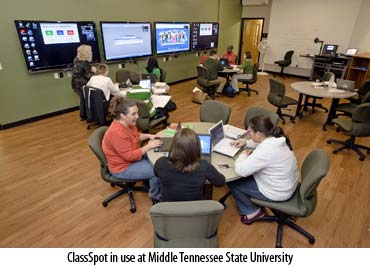Universities Use Collaborative Software To Share Classroom Displays
- By Linda L. Briggs
- 04/01/09
If there's a single most powerful benefit from using a collaborative software tool called ClassSpot, according to Stanford's Menko Johnson, it's this: It lets an instructor control multiple display screens in a classroom simply and cost-effectively. "That's huge," Johnson said. "Whenever you have a classroom beyond a single display, you enter a whole new environment of multiple computers displaying different things at the same time.... But how do you run this multimedia show without letting it take over the entire class?"
Johnson, who is currently an instructional designer and technologist at the Stanford Center for Innovations in Learning, said that ClassSpot, a collaborative software product from a Palo Alto, CA-based company called TideBreak, greatly assists in orchestrating the "powerful pedagogy" of multiple displays.
As an instructional technologist at San Jose State University, he saw ClassSpot in action with a wide variety of instructors and class types over several years. That's when the collaborative powers of ClassSpot became even more apparent to him--Johnson had worked with TideBreak CEO Andrew Milne from the product's inception at Stanford and thus had a sense of its capabilities.
ClassSpot makes a classroom with one or more large public display screens interactive. Essentially, each of the large public screens in class can become collaborative devices, with students and faculty able to contribute and manipulate content on one or all of the public screens from their own computers. Each user's computer screen can also become a collaborative device.
When ClassSpot is running on a student or instructor computer and proper access controls are set, the edge of the screen is no longer a barrier. Instead, Johnson said, the screen edge becomes "like a speed bump. Students can take the mouse and run it to the top of [their notebook computer] screen, then look up to the main screen in the center of the room, and [the student's] mouse is now controlling the computer."
Tidebreak also offers TeamSpot, a group collaboration product. An enhanced version of ClassSpot for team projects called ClassSpot PBL (for Project-Based Learning) combines ClassSpot with multiple TeamSpots for student teams working in groups. The software ideas originated with a research project at Stanford University several years ago, where Milne and Tidebreak co-founder Brad Johanson were working on their Ph.D.s.
At SJSU, Johnson said, ClassSpot "solved a critical need in our [SJSU] classrooms: How do you use three screens effectively?" One common configuration with ClassSpot, he said, was a PowerPoint presentation on a center screen with electronic whiteboards on either side. That allowed Web pages, links and hand-written annotations to be displayed on either side of the main display. In a poetry class, for example, a poem could be shown on one screen, links to audio files on another, and PowerPoint slides with information on the third. Students and faculty could listen, rewrite, mark up the poem, and click on links to other information--all while the poem remained on the central screen.
At Middle Tennessee State University, two TideBreak products are in use in two classrooms. MTSU is using both TeamSpot and ClassSpot PBL--TeamSpot for student-to-student collaboration, and ClassSpot PBL for faculty-to-student collaboration.
K. Watson Harris, who is both an administrator (director of academic technology planning) and an adjunct at MTSU, said she uses ClassSpot to enable students to share documents in class--"Like e-mailing or passing a flash drive back and forth, but much simpler." Students running ClassSpot on their notebook computers in class can simply "slide" a shared document from their computers onto the public screen. One distinct advantage, Harris said: She can easily share a document or other file with all students, have everyone work on it collaboratively in class, then save it to an archive and pick up the document in the next class right where they left off.
Harris said she finds TeamSpot useful for collaborative research in her graduate school classes. "[TeamSpot] is important for students doing research on individual subjects ... related to a group topic.... They are individually writing around a topic, then they'll merge all their research for a presentation." In that case, students can use TeamSpot to easily share data, documents, links or other information among themselves. Using TeamSpot and ClassSpot, Harris can also monitor everyone's contribution: "Each individual has to participate. There are no slackers,... which can be a problem with teams."
With ClassSpot, instructors can decide how much control of the public screens they want to cede to students. Harris can lock out all students and control the three screens herself, can display a passcode so all students in the class can access one or more screens, or can allow a select student to take over a display. That student might, for example, share an Internet link useful to the entire class or mark up an equation or piece of text while the class watches.
At SJSU, Johnson said, ClassSpot was "a tremendous tool" in a computer science class. Instead of each student writing a section of software code, then the professor visiting each desktop to correct the segment, one student could project his or her code on the screen for correction and comment in front of the entire class.
ClassSpot's design can save money, Johnson said, because unlike other multi-screen solutions, it requires no wires, video signal, or need to switch to another computer in order to control a public display. "ClassSpot solved a critical problem in our space." Johnson said, "which was, how do you use three screens effectively without having to use three different computers?" Instead, ClassSpot works by interacting with the computer driving the display device--whether large projected screen, electronic whiteboard, or another device. The computer controlling the device plugs into a network port, making for a much less costly solution.
About the Author
Linda Briggs is a freelance writer based in San Diego, Calif. She can be reached at [email protected].